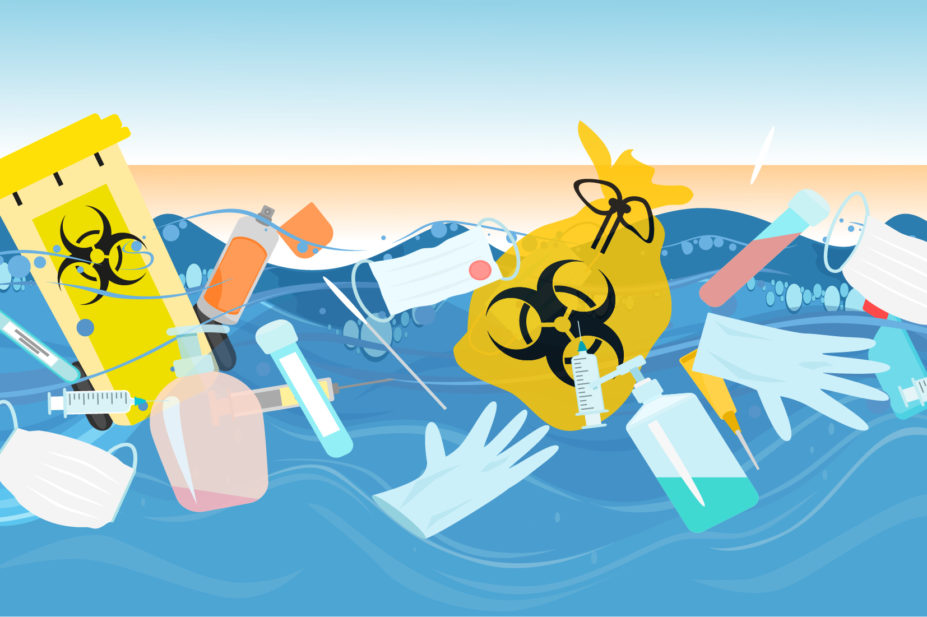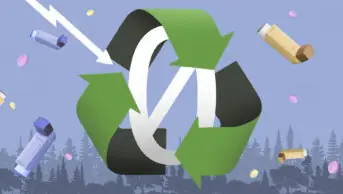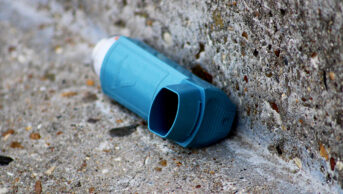
Mclean
The Intergovernmental Panel on Climate Change has outlined that the climate emergency is widespread, rapid and intensifying: many of the impacts of climate change are irreversible and “strong and sustained” change is needed[1].
Medicines (and their ancillaries) have notable sustainability issues that can impact on health, such as the release of climate change gases or pharmaceutical pollution[2]. Noting the words of Tracy Lyons — founder of Pharmacy Declares, a network of pharmacy professionals calling for sustainable change — “pharmacy can do it”.
It is positive to see pharmacy organisations, such as the Royal Pharmaceutical Society, make an associated declaration[3,4]. However, active engagement across the profession requires us all to consider how we do this in everyday practice.
For pharmacy professionals who provide support to people who use substances, there are a range of issues to consider, over and above those that impact other clinical specialities.
Single-use plastics
When offering pharmacological treatment interventions for people who use substances, such as opioid substitute medication, using single-use plastics creates sustainability issues. While such plastics are widely used in healthcare, arguably, in opioid substitution, because of the typical need for daily-dose dispensing and containers for supervised consumption (to mitigate safeguarding and diversion risks), the utilisation of single-use plastics is likely higher compared with other medication.
Recycling or reusing containers is complicated by the presence of controlled drugs. Take-away doses of liquid methadone are commonly dispensed in daily-dose amber plastic bottles, as this is cheaper compared with glass bottles and has a lower risk of breakage. Prescribers could consider avoiding dispensing daily-dose containers, but there would have to be consideration of clinical safety and the person’s ability to measure out their own doses.
Currently, there is no incentive for individuals to recycle medicines bottles and there is a lack of clear guidance on whether medicines bottles can be rinsed and recycled, because of concerns about medication entering the water system, medicines safety, diversion and confidentiality, if dispensing labels are not appropriately removed.
There is also no system in place to enable bottles to become multi-use by way of return and sterilisation. The development of such a system would require development of infrastructure and agreement across treatment providers, commissioners and pharmacy contractors to manage associated costs and logistics. Similarly, pharmaceutical, clinical and sharps waste is currently disposed of in single-use bins, which are incinerated; promoting the use of reusable waste bins could further reduce the environmental impact of waste disposal.
Dispensing arrangements
Specialist substance misuse treatment providers have worked hard to liberalise dispensing arrangements during the early phase of the COVID-19 pandemic. In accordance with guidance from Public Health England (now the Office for Health Improvement and Disparities), many reduced the frequency of pharmacy collections from daily up to once per fortnight, dependent upon individualised risk assessments[5]. This guidance has since been rescinded as pandemic restrictions have eased and the usual one-week maximum for take-home supplies has been reinstated[5].
Of course, the need for daily supervised consumption, or more frequent pharmacy visits, is dependent upon a person’s needs and clinical safety remains paramount; however, more frequent travelling can add to an individual’s carbon footprint, especially in more rural areas where cars are more likely to be required for transportation.
Additionally, instalment prescriptions cannot be provided electronically at this time, leading to more paperwork and a greater carbon footprint, as more prescription deliveries are needed. Often, the introduction of electronic prescribing has simply shifted the requirement to print the prescription from the prescriber to the pharmacy. However, fully integrated electronic prescribing systems for substance misuse would have additional benefits in reducing the number of lost, stolen and misplaced prescriptions, in turn improving clinical governance processes and quality of care provision; for example, by enabling more timely dispensing by the pharmacy team[6].
Paraphernalia
Needle syringe provision is another important intervention provided by community pharmacy and specialist treatment services. Increasing the use of paraphernalia that are manufactured with minimal plastic content and incorporate reprocessed plastics, without impacting upon product integrity or escalating costs, should be considered during procurement processes. For example, procurement should consider provider accreditation, signifying that they meet established national standards such as ISO 14001:2015, which relates to environmental management systems, and comply with Operation Clean Sweep — an initiative to reduce plastic pellet loss to the environment[7,8].
Drug litter poses an environmental risk and also exposes others to the risk of sharp injuries. This is perhaps most often seen where there is poor access to safe disposal devices. To mitigate this, sharps bins must be made more available in public spaces.
Measures such as moving away from ‘packs’ of equipment and instead taking a ‘pick n mix’ approach would reduce wastage
Treatment services actively promote single-use equipment to reduce the risk of transmission of blood-borne viruses, but the use of single-use plastics and sharps bin incinerations are not sustainable. Measures such as moving away from providing ‘packs’ of equipment and instead taking a ‘pick n mix’ approach — where people are only provided with the exact amount and type of equipment they require — would reduce wastage and needle finds. However, this approach would require additional storage space and may be perceived as increasing workload. A focus on returns could be incentivised if payments to pharmacies providing needle syringe provision were split between activities relating to making supplies and accepting returns. Furthermore, waste collectors need to continue efforts to work with providers when measuring return rates and tracking them over time to proactively identify where further work may be required.
Drug-related litter is associated with paraphernalia from people injecting substances and from administration by other routes, such as inhalation. For example, when people smoke substances such as crack-cocaine, they often use homemade devices made from household items, such as steel wool scouring pads and pens. In comparison, professionally-produced pipes made from glass can be recycled, are associated with a lower risk of burns injuries and reduce the release of toxic chemicals during the heating process.
Providing people with ‘crack pipes’ as a harm reduction measure is not permissible under current legislation. If this was changed, pipes could be supplied as an extension to existing needle syringe provision (including those currently provided via pharmacies), while a sustainable waste management system for return and recycling of glass pipes is developed.
Ensuring adequate coverage of harm reduction devices, such as crack pipes and injection paraphernalia, is essential to reduce the risks associated with people sharing and increasing communicable disease transmission, such as blood-borne viruses and COVID-19[9]. Improving needle syringe provision coverage by ensuring that adequate amounts of paraphernalia are distributed is also important when considering national plans to eliminate hepatitis C and reducing the risk of other infections associated with sharing or reusing equipment[9,10,11].
This approach could also be extended to nitrous oxide gas, which is known to have potent greenhouse effects. There are moves to eradicate its use via the #nixthenitrous project, although this does not include recreational use[12]. When misused (usually for euphoric and relaxing effects), small canisters or ‘whippets’ are discharged and the contents inhaled. Once used, the empty canisters are too often irresponsibly discarded and, arguably, it is this littering that has led the British government to consider the need to review the legal status of nitrous oxide[13]. However, perhaps a contingency management approach where people are remunerated for recycling their used containers would be more proportionate and pharmacies could have a role in offering access to such initiatives[14].
Drug policy
Probably the most contentious harm-reduction approach requiring a change in drug policy is the provision of ‘safe spaces’ to use drugs — indoor environments where people can use drugs with trained personnel on site, who are able to provide overdose reversal and harm reduction services. These spaces could support increased safe disposal of paraphernalia and minimise waste by ensuring that only the required equipment is utilised. Unfortunately, despite the international evidence base, support from the Faculty of Public Health and numerous signatories, including those from the pharmacy profession and the British government’s own Advisory Council on the Misuse of Drugs, such facilities are yet to be endorsed by the government[15–17].
There is a need to take better care of people who use drugs in other settings too, such as at music festivals. Drug use in these situations also impacts on the environment; for example, recreational drug use during festivals was recently highlighted in the media because of research by Aberg et al., who reported on the local impact of illicit pharmaceutical waste following the 2021 Glastonbury festival[18]. Taking steps to improve access to anonymised facilities that enable safe disposal of unwanted substances (perhaps via onsite pharmacies) and ensuring appropriate sewerage systems in these settings should minimise the associated impact.
The challenges associated with improving the care for people who use substances are compounded because of stigma and current legislation including the Misuse of Drugs Act: a change to regulating the illicit market may further support safe disposal by improving accessibility to, and use of, safe disposal facilities. Also, it would present an opportunity to hold illegal (non-regulated) producers to account for the environmental damage they cause; for example, deforestation for coca-growing or toxic by-product disposal associated with MDMA manufacturing. Illicit production contaminates waterways, pollutes the surrounding soil and releases toxic gases into the atmosphere[19].
Additionally, drug trafficking has a notable carbon footprint arising from international travel and deforestation, and catastrophic damage is caused by futile aerial fumigations, indiscriminately destroying endangered species without notable impact upon cultivation levels[20,21].
Legislative change could ensure that that renewable energies are used for drug cultivation and pharmacies are able to have more of a role in the provision of safe supplies[22]. For example, the role that pharmacy could play after legislative changes have been outlined by Rolles and Gittins when considering a different approach to the use of stimulants[23]. Ultimately, however, drug war-related conflict and corruption undermines many state institutions, making implementation of sustainability goals becomes impossible.
In summary, much more needs to be done to promote sustainability across the pharmacy profession and beyond, and there is a need for proactive engagement. The impact of the illicit drugs trade is too often forgotten and for those providing support to people who use substances, current legislation and existing processes need to be changed to facilitate the improvements that are required. There is an acute need for these issues to be considered at national and international level as we continue to actively seek to make improvements in the specialist treatment service provision.
No conflicts of interest were declared by the authors of this article.
- 1AR6 Climate Change 2021: The Physical Science Basis. Intergovernmental Panel on Climate Change. 2021.https://www.ipcc.ch/report/ar6/wg1/#FullReport (accessed Mar 2022).
- 2Wilkinson JL, Boxall ABA, Kolpin DW, et al. Pharmaceutical pollution of the world’s rivers. Proc Natl Acad Sci USA. 2022;119:e2113947119. doi:10.1073/pnas.2113947119
- 3Pharmacy must declare a climate emergency. Pharmaceutical Journal. 2021. doi:10.1211/pj.2021.1.82489
- 4RPS Declaration of Climate and Ecological Emergency. Royal Pharmaceutical Society. 2021.https://www.rpharms.com/about-us/sustainability/declaration (accessed Mar 2022).
- 5COVID-19: guidance for commissioners and providers of services for people who use drugs or alcohol. Department of Health & Social Care and Public Health England. 2021.https://www.gov.uk/government/publications/covid-19-guidance-for-commissioners-and-providers-of-services-for-people-who-use-drugs-or-alcohol/covid-19-guidance-for-commissioners-and-providers-of-services-for-people-who-use-drugs-or-alcohol (accessed Mar 2022).
- 6Pharmacy costs and benefits study: key points for community pharmacy teams. NHS Digital. 2021.https://digital.nhs.uk/services/electronic-prescription-service/pharmacy-costs-and-benefits-study-key-points-for-community-pharmacy-teams (accessed Mar 2022).
- 7ISO 14001:2015 Environmental management systems — requirements with guidance for use. International Organization for Standardization. 2015.https://www.iso.org/standard/60857.html (accessed Mar 2022).
- 8Become a supporter. Operation Clean Sweep. 2022.https://www.opcleansweep.org/ (accessed Mar 2022).
- 9Vickerman P, Martin N, Turner K, et al. Can needle and syringe programmes and opiate substitution therapy achieve substantial reductions in hepatitis C virus prevalence? Model projections for different epidemic settings. Addiction. 2012;107:1984–95. doi:10.1111/j.1360-0443.2012.03932.x
- 10Hepatitis C in England 2020: Working to eliminate hepatitis C as a major public health threat. Public Health England. 2020.https://assets.publishing.service.gov.uk/government/uploads/system/uploads/attachment_data/file/898221/HCV_in_England_2020_report.pdf (accessed Mar 2022).
- 11Larney S, Peacock A, Leung J, et al. Global, regional, and country-level coverage of interventions to prevent and manage HIV and hepatitis C among people who inject drugs: a systematic review. The Lancet Global Health. 2017;5:e1208–20. doi:10.1016/s2214-109x(17)30373-x
- 12Chakera A. The Nitrous Oxide Project: #nixthenitrous. University of Edinburgh. 2022.https://www.ed.ac.uk/medicine-vet-medicine/postgraduate/postgraduate-blog/the-nitrous-oxide-project-nixthenitrous
- 13Patel P. Nitrous Oxide: Home Secretary’s letter to the ACMD. Advisory Council on the Misuse of Drugs. 2021.https://www.gov.uk/government/publications/nitrous-oxide-home-secretarys-letter-to-the-acmd/nitrous-oxide-home-secretarys-letter-to-the-acmd-accessible-version (accessed Mar 2022).
- 14Nutt D, Winstock A, Eastwood N, et al. Parliamentary briefing on tackling the misuse of Nitrous Oxide. Drug Science. 2020.https://www.drugscience.org.uk/parliamentary-briefing-on-tackling-the-misuse-of-nitrous-oxide/ (accessed Mar 2022).
- 15A call to pilot Overdose Prevention Centres (Supervised Injecting Facilities) in the UK. Faculty of Public Health. 2022.https://www.fph.org.uk/media/3412/fph_opc_statement-04-01-2022.pdf (accessed Apr 2022).
- 16Reducing opioid-related deaths in the UK. Advisory Council on the Misuse of Drugs. 2016.https://assets.publishing.service.gov.uk/government/uploads/system/uploads/attachment_data/file/576560/ACMD-Drug-Related-Deaths-Report-161212.pdf (accessed Mar 2022).
- 17Atkins V. Letter to Owen Bowden-Jones, chair of the Advisory Council on the Misuse of Drugs. Home Office. 2018.https://assets.publishing.service.gov.uk/government/uploads/system/uploads/attachment_data/file/699825/Letter_from_Victoria_Atkins_MP_to_OBJ.pdf (accessed Mar 2022).
- 18Aberg D, Chaplin D, Freeman C, et al. The environmental release and ecosystem risks of illicit drugs during Glastonbury Festival. Environmental Research. 2022;204:112061. doi:10.1016/j.envres.2021.112061
- 19How to regulate stimulants. Transform Drug Policy Foundation. 2020.https://transformdrugs.org/publications/how-to-regulate-stimulants-a-practical-guide (accessed Mar 2022).
- 20Addressing the development dimensions of drug policy. United Nations Development Programme. 2015.https://www.undp.org/publications/addressing-development-dimensions-drug-policy (accessed Mar 2022).
- 21The alternative world drug report. Transform Drug Policy Foundation. 2016.https://transformdrugs.org/publications/the-alternative-world-drug-report-2nd-edition (accessed Mar 2022).
- 22How to regulate cannabis: a practical guide. Transform Drug Policy Foundation. 2016.https://transformdrugs.org/publications/how-to-regulate-cannabis-a-practical-guide (accessed Mar 2022).
- 23Pharmacists can help put an end to illicit drug deaths by being at the centre of a new non-medical use market. The Pharmaceutical Journal. 2020. doi:10.1211/pj.2020.20208600


